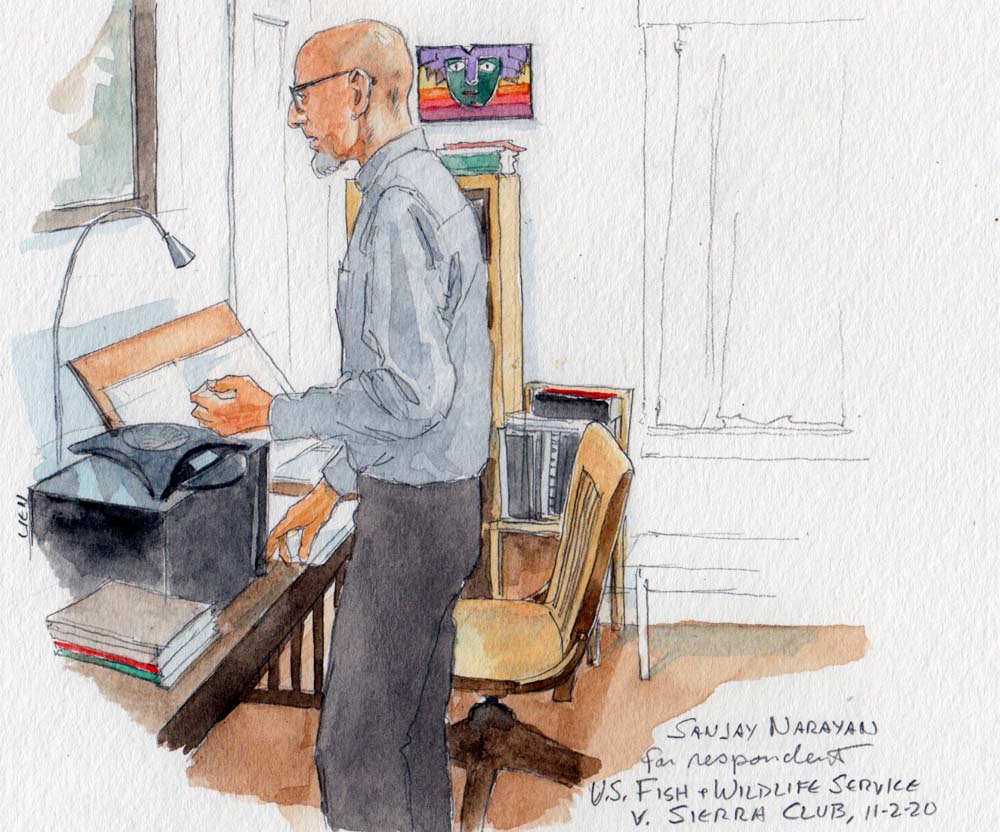Argument analysis: Court considers bright-line and case-specific standards for the Freedom of Information Act’s “deliberative process” privilege

The Supreme Court heard oral argument on Monday morning in a case that will determine the scope of transparency under the Freedom of Information Act’s key “deliberative process” privilege. U.S. Fish and Wildlife Service v. Sierra Club presents the question of whether the privilege allows the government to withhold documents prepared as part of a statutorily required interagency consultation process between the U.S. Fish and Wildlife Service and National Marine Fisheries Service (collectively, “the services”) and the Environmental Protection Agency. This was the first case argued before the court since Justice Amy Coney Barrett took the bench.

FOIA promotes transparency in government decision-making by providing the public with a right to access federal records. There are, however, nine categories of records that FOIA exempts from disclosure. Under exemption 5, records that are “inter-agency or intra-agency memorandums or letters that would not be available by law to a party other than an agency in litigation with the agency” are protected from disclosure. The Supreme Court has interpreted this exemption as protecting records that would be privileged against discovery in civil litigation, including those that fall under the deliberative process privilege. This privilege protects “documents reflecting advisory opinions, recommendations and deliberations comprising part of a process by which governmental decisions and policies are formulated.” For this privilege to apply, documents must be “predecisional” and “deliberative.”
The documents at issue in this case were prepared during the interagency consultation process required under Section 7 of the Endangered Species Act, which prohibits federal agency actions that will cause “jeopardy” — harm to the continued existence of listed species or adverse modification of critical habitat. In 2011, EPA proposed new regulations for cooling water intake structures, which can cause harm to aquatic life when drawing in large volumes of water. During the requisite Section 7 consultation, the services found that EPA’s proposed regulations would jeopardize protected species and prepared biological opinions that reflected this finding in December 2013 along with draft “reasonable and prudent alternatives.” The services sent EPA portions of these documents, after which EPA revised its proposed rule and sent it back to the services in March 2014. The services issued a final biological opinion concluding the revised proposal was not likely to jeopardize listed species or critical habitat, and EPA issued its final rule in May 2014.
Sierra Club submitted a FOIA request for the December 2013 biological opinions, among other documents. A federal district court ruled that the documents were not protected, and the U.S. Court of Appeals for the 9th Circuit agreed in part, determining that some of the documents, including the December 2013 biological opinions, do not fall under the deliberative process privilege and thus must be disclosed. The Supreme Court agreed in March to review the case.
Matthew Guarnieri, arguing for the services, began oral argument by invoking a phrase used by then-Judge Brett Kavanaugh in his 2014 opinion for the U.S. Court of Appeals for the District of Columbia Circuit in National Security Archive v. Central Intelligence Agency. Guarnieri said that the December 2013 opinions “died on the vine” when EPA abandoned its 2011 proposed rule, and thus were predecisional and deliberative.
Chief Justice John Roberts initially inquired about the services’ threshold determination that the May 2014 biological opinion, and not EPA’s revised rule, constitutes the final decision for the purposes of FOIA. Guarnieri explained that Section 7 of the ESA makes clear that the interagency consultation process concludes with issuance of the final biological opinion, but added that even if the court views the process more broadly to include EPA’s rulemaking, the December 2013 biological opinions would still be predecisional with respect to EPA’s final rule. Justice Neil Gorsuch posed a series of related hypotheticals regarding what documents would need to be disclosed, including one in which EPA’s decision “died on the vine” because the agency abandons its rule altogether. Kavanaugh verified that it was the services’ position that even a final agency opinion could be predecisional “as part of a broader deliberative process.”
The justices asked several questions about where to draw the line between predecisional and final documents. Is it that “anything short of just pressing the send button” is nonfinal, as Justice Clarence Thomas asked? Is it, as Justice Samuel Alito asked, that “no draft biological opinion can ever be final”? In response to Thomas, Guarnieri stressed that while transmittal is not the dispositive factor, until an agency issues a final decision, the agency decisionmakers are free to change their mind. In response to Alito, Guarnieri pointed out that, by definition, a draft opinion is predecisional and deliberative, again emphasizing that the agency has not made up its mind.
Alito, along with Justices Stephen Breyer and Elena Kagan, suggested that the December 2013 biological opinions could be considered final documents. Specifically, Kagan was unconvinced that “the very general statement” in the agency’s declaration that “more work needed to be done” suggested the opinions were not final. She pointed out that the agencies seemed to treat the opinions as final by sending alternatives and ultimately revising EPA’s rule.
Justice Sonia Sotomayor pressed Guarnieri on the “powerful coercive effect” biological opinions have on the action of an agency, as the court has previously held. Here, EPA did revise its proposed rule based on the December 2013 biological opinions. Guarnieri maintained that while final biological opinions have legal force and effect, draft opinions do not. Sotomayor also made a point of verifying that should the court rule in the services’ favor, a remand would be appropriate to determine whether the documents contain discrete factual information that would not be protected and could be separated out and disclosed under FOIA.
Breyer and Kagan probed the public interests the court must balance in government decision-making — transparency and accountability on the one hand and candid federal agency deliberation on the other. Breyer questioned whether disclosure would in fact “diminish agency decision-making quality,” and Kagan raised concerns regarding agency efforts to evade FOIA requirements. Kavanaugh followed up on this, asking whether “the motive of an agency official with respect to FOIA play[s] a role in determining how a court should assess whether it is obtainable under FOIA.” Guarneiri responded that motive is not traditionally part of the analysis, and although some courts have determined an agency may have “implicitly” reached a final decision, that is not the case here.
Kavanaugh also asked Guarneiri to address the concern that agency officials could label documents as “draft” to avoid disclosure. Guarneiri reiterated that asking whether a document is predecisional and deliberative comports with the court’s case law, adding that the court could look to other factors beyond how a document is labeled in making that determination. Barrett, however, pointed out that looking to other factors is “pretty fact-intensive,” and made sure to clarify that the services would prefer a bright-line standard.
Sanjay Narayan, arguing on behalf of Sierra Club, began by asserting that exemption 5 does not apply if a document explains a decision made by an agency and has “appreciable legal consequences.” Narayan emphasized that the ESA gives the services “decisive gatekeeping authority over other agencies,” but that, troublingly, the services “almost never exercise their jeopardy authority through final jeopardy opinion.” To allay Barrett’s concerns regarding the fact-intensive nature of an “appreciable legal consequences” standard, Narayan pointed out that lower courts have resolved cases for 40 years on summary judgment based on their evaluation of similar factors. Nonetheless, Roberts expressed concern regarding the workability of a test based on the effect of the decision, noting that in most cases it is difficult to identify a specific point in the decisional process that drove the decision.
Breyer’s series of questions seemed simply for the purpose of clarifying the test Sierra Club put forth, and he seemed satisfied with Narayan’s responses. Alito, on the other hand, did not seem satisfied that such a test would help distinguish between opinions labeled as drafts to determine which is subject to FOIA. Kavanaugh also expressed concern with the test, stressing the need for clear rules for agencies, FOIA officers and district courts. Barrett seemed to question whether the documents in this case even met Sierra Club’s test, asking why the agency’s decision to revise its rule based on the December 2013 biological opinions was “a legal effect as opposed to simply a practical effect.”
Thomas and Sotomayor both asked why Sierra Club wants to see draft biological opinions regarding an EPA rule that no longer exists. Narayan explained that because EPA’s final rule allows the services to review subsequent Clean Water Act permits in order to protect listed species, without the December 2013 biological opinions, the public could not discern whether such future permit review is consistent with the basis for the changes EPA made to the rule.
As with Guarnieri, Kagan asked Narayan about the agency’s declaration that more work needed to be done. Kagan pushed back on Narayan’s attempt to dismiss the declaration as a conclusory statement and suggested that, given there is nothing that indicates the declarations are false, they weigh in favor of exemption 5 applying here. Earlier, Thomas similarly asked Narayan, “Why don’t we take [the services] at their word?”
Gorsuch noted the public interest in allowing federal agencies to candidly deliberate, pointing out that such deliberation led to what Narayan acknowledged was a better policy outcome. Narayan tried to allay Gorsuch’s concern that “a more invasive rule might deter this kind of productive back-and-forth” by pointing out that biological opinions consist mostly of scientific studies and facts, and stressed the importance of disclosure in cases like this one, where one agency has “effective authority” and the other agency is “acting like a subordinate.”
On balance, the justices’ queries during oral argument appear to suggest agreement with the services’ assertions that the documents were produced in “the molten core of deliberative process” and thus protected. Yet only time will tell; indeed, it remains unclear whether the court will opt for a bright-line standard or a more fact-intensive inquiry about what qualifies as “predecisional.”
Posted in Merits Cases
Cases: U.S. Fish and Wildlife Service v. Sierra Club
